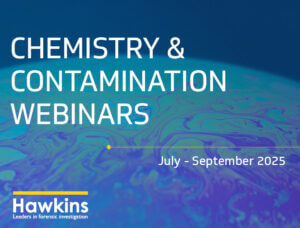From July to September 2025, join our Chemistry and Contamination experts as they host a new series of webinars. This series will cover a range of topics, including failures of contaminated polymeric materials, mould contamination and the impact of common chemicals on alloys.
For webinar details and to register, please see below.
If you would like further information on each webinar before registering, please click on the titles below. Our events page provides details of other Hawkins events that you may find of interest.
Chemical Analytical Techniques in Contamination Investigations
Presented by Dr James Morris
Thursday 3rd July 2025 at 9.30am BST
James explores the critical role of chemical analysis in forensic science. He introduces key analytical techniques and explains how they are used to identify and quantify substances in complex investigations, outlining how certain scientific methods can be applied to real-world cases.
Contamination & its Role in Causing Degradation of Metals
Presented by Dr Philippa Moore
Thursday 17th July 2025 at 9.30am BST
Philippa will look at three common alloys (carbon steel, stainless steel, and brass) as well as common chemicals that can cause them to crack and prematurely fail, such as those that you might have sitting under your kitchen sink.
A Scientific Approach to the Problem of Post-Incident Recovery
Presented by Ed Hammersley
Thursday 31st July 2025 at 9.30am BST
Contamination can be caused by a multitude of different issues such as fire, water, mould and asbestos. Ed will talk about these different types of contamination, their sources, and how they are detected and quantified, before detailing some worked examples.
He will also discuss the use of technology in contamination assessments including its role in the mitigation of both the direct cost and business interruption and also how these technologies can assist the insurer.
Breaking the Mould
Presented by James Townsend
Thursday 14th August 2025 at 9.30am BST
Mould contamination can occur to a range of substrates including commercial and domestic building materials, timber, soft furnishings, fabrics and plastics. It can also affect warehouse stock packaging and materials used to pack product shipments in marine containers.
This presentation investigates some of the many types of mould species involved, how they can be used to determine the cause and the timing of the contamination, and their potential effects on air quality and human health. James will also cover some measures that can be taken to remediate contaminated materials.
Contamination of Plastic is Not so Fantastic
Presented by Jacek Czech
Thursday 28th August 2025 at 9.30am BST
Failures of polymeric materials can be caused by a number of factors, but contamination is perhaps one of the most interesting causes of failures that we come across. Contamination can be internal or external, it may result in almost instant or significantly delayed failures and quite often it cannot be easily detected until the failure occurs.
Jacek provides insight into how polymeric materials can become contaminated and how this can lead to failures.
Chemical Hazards:
Risks Associated with Chemistry Laboratories & Processing Environments
Presented by Dr Ben Barron
Thursday 11th September 2025 at 9.30am BST
Ben discusses some of the inherent chemical hazards found in chemistry laboratories and processing areas. He will focus on hazards associated with chemical compatibility and reactivity, the use of flammable solvents, and chemical exposure.
These hazards can pose risk of fires, chemical spills, overpressure events and personal injury, sometimes with catastrophic outcomes. Ben will briefly explore the main contributing factors that exacerbate the frequency of such events and how these can be mitigated.
We look forward to presenting for you.







